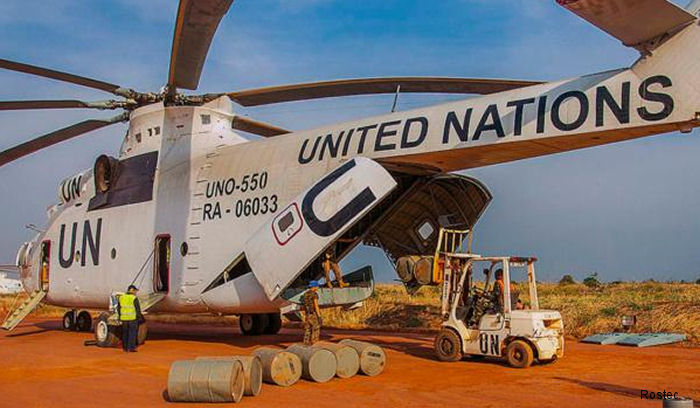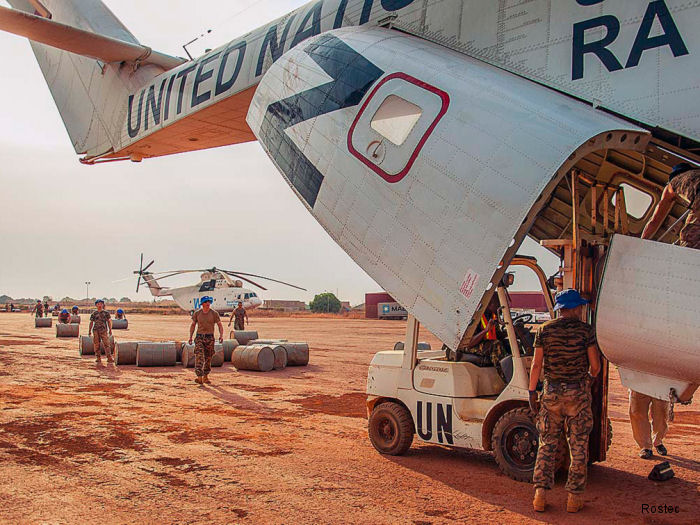Rostec, March 17, 2015 - Mi-26T helicopters, built by Rostvertol Helicopter Factory and designed by Mil Moscow Helicopter Plant, both holdings of Russian Helicopters, are participating in missions of the UN and the World Food Program in the Republic of South Sudan.
Humanitarian work in South Sudan began in August 2014 and will continue through 2015. Four Mi-26T helicopters are already in the African republic, and another helicopter will be sent there in March of this year. The helicopters are owned by Russian commercial airlines and are used to transport food, equipment, and fuel to disaster areas.
Each helicopter can carry per flight up to 12 tons of cargo, an optimal load for transportation in an environment where the temperature rises to 40° C. The heavy Mi-26T helicopters can land on unprepared sites, which is particularly relevant for South Sudan.
According to estimates of the charitable organization Doctors Without Borders, the African country is now on the verge of a humanitarian catastrophe. The Children’s Fund UNICEF has reported that millions of children have been affected by the lack of food and medical services in South Sudan. The international community is trying to help by sending humanitarian aid to the country.
Based on its technical and economic characteristics, the Mi-26T, the most load-bearing helicopter in the world, has no equal. Helicopters of this type are widely used to perform a variety of tasks, including transportation, evacuation, fire fighting, and more. The Mi-26T is capable of carrying 20 tons of cargo inside the fuselage or as an external load.
The helicopter is constantly being improved. The upgraded Mi-26T2 is now undergoing flight tests. The aircraft is being reequipped with advanced avionics that can be used at night. The helicopter’s ergonomics have been significantly improved, which increases the overall efficiency of the helicopter.
Today, aircraft from Russian Helicopters are widely used for accomplishing the most urgent and important tasks of the United Nations in different regions of the world. These helicopters have proven their worth in this work. This includes the Mi-26T transportation helicopter, the Mi-8/17 multipurpose helicopters, and the specialized Ka-32 helicopter. In total, over 150 Russian-made helicopters are involved in peacekeeping and humanitarian missions.
The urgency of UN missions requires timely delivery of helicopters to the scene. Russian-made helicopters are easy to transport, as their disassembly for transportation in airplanes as well as on-site assembly takes minimum time. Moreover, the helicopters produced by Russian Helicopters are adapted for storage outside of hangers and can be utilized away from service bases, as flight technicians can carry out needed maintenance work on the helicopters themselves.
Humanitarian work in South Sudan began in August 2014 and will continue through 2015. Four Mi-26T helicopters are already in the African republic, and another helicopter will be sent there in March of this year. The helicopters are owned by Russian commercial airlines and are used to transport food, equipment, and fuel to disaster areas.
Each helicopter can carry per flight up to 12 tons of cargo, an optimal load for transportation in an environment where the temperature rises to 40° C. The heavy Mi-26T helicopters can land on unprepared sites, which is particularly relevant for South Sudan.
According to estimates of the charitable organization Doctors Without Borders, the African country is now on the verge of a humanitarian catastrophe. The Children’s Fund UNICEF has reported that millions of children have been affected by the lack of food and medical services in South Sudan. The international community is trying to help by sending humanitarian aid to the country.
Based on its technical and economic characteristics, the Mi-26T, the most load-bearing helicopter in the world, has no equal. Helicopters of this type are widely used to perform a variety of tasks, including transportation, evacuation, fire fighting, and more. The Mi-26T is capable of carrying 20 tons of cargo inside the fuselage or as an external load.
The helicopter is constantly being improved. The upgraded Mi-26T2 is now undergoing flight tests. The aircraft is being reequipped with advanced avionics that can be used at night. The helicopter’s ergonomics have been significantly improved, which increases the overall efficiency of the helicopter.
Today, aircraft from Russian Helicopters are widely used for accomplishing the most urgent and important tasks of the United Nations in different regions of the world. These helicopters have proven their worth in this work. This includes the Mi-26T transportation helicopter, the Mi-8/17 multipurpose helicopters, and the specialized Ka-32 helicopter. In total, over 150 Russian-made helicopters are involved in peacekeeping and humanitarian missions.
The urgency of UN missions requires timely delivery of helicopters to the scene. Russian-made helicopters are easy to transport, as their disassembly for transportation in airplanes as well as on-site assembly takes minimum time. Moreover, the helicopters produced by Russian Helicopters are adapted for storage outside of hangers and can be utilized away from service bases, as flight technicians can carry out needed maintenance work on the helicopters themselves.
Mi-26 Halo UNO-550 ( United Nations )
See also |
WFP World Food Programme United Nations
United Nations






